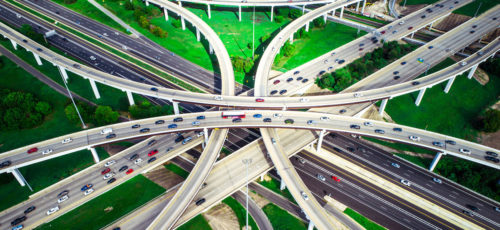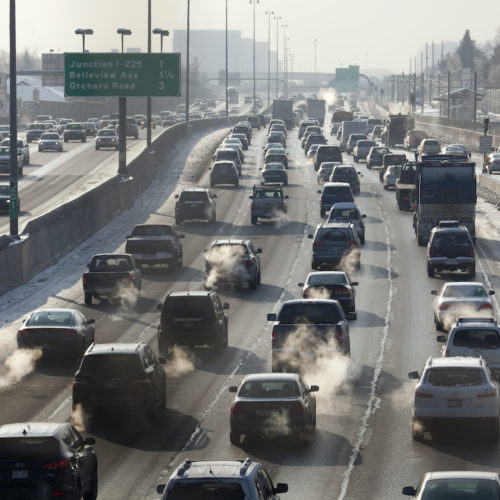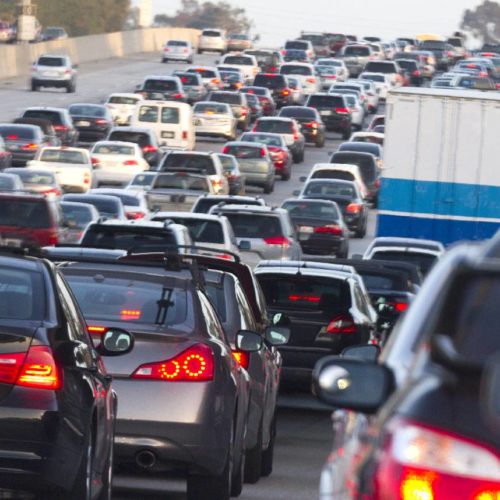
More Lanes Do Not Mean Less Traffic
RMI’s New SHIFT Calculator Shows that Highway Expansions Lead to More Emissions
In Austin, Texas, a battle is underway to reverse the ills of a highway that is increasingly perceived as a racial and environmental scar on the city. Running through the heart of the city, I-35 evolved over the decades from a modest boulevard to an elevated, double-decker highway that divides downtown from the east side of the city. Its history is highly problematic, as it was the dividing line across which the City of Austin once forced Black households to move during the Jim Crow era. And in the time that is has expanded, the highway has displaced households and exposed Austinites to increasing levels of air pollution.
Today, the Texas Department of Transportation (TxDOT) wishes to widen the highway to relieve what is undoubtedly a highly congested highway in one of the fastest growing cities in America. TxDOT assumes, like most transportation departments, that adding more lanes will relieve congestion.
However, at a cost of $8 billion for just eight miles of highway, the planned highway expansion will displace properties and actually increase driving and emissions in a city that prides itself on its environmental ethos. In addition, last year saw the successful passage of a referendum that will fund a $7 billion citywide expansion of the City’s high-frequency bus and light-rail system. TxDOT’s costlier highway plans threaten to reduce the efficacy of the City’s transit investment by encouraging more people to drive, while also further disconnecting neighborhoods.
A new tool that RMI released today—the SHIFT (State Highway Induced Frequency of Travel) Calculator—shows how highway expansions, such as the one in Austin, fail to reduce congestion and instead increase traffic and pollution. The tool can support transportation agencies in making smarter, more sustainable transportation investments.
The SHIFT Calculator and Induced Demand
The SHIFT Calculator provides new insight into the travel and environmental impacts of highway expansions. Created in partnership with NRDC, Transportation for America, and UC Davis, this tool uses highway lane mile data collected through the US Department of Transportation and enables users to estimate the amount of vehicle-miles traveled that a widening project will incur on a highway or arterial road. For the Austin example, the Calculator projects that TxDOT’s plans would generate 255 million to 382 million additional vehicle miles traveled (VMT) per year—the emissions equivalent of adding approximately 32,500 passenger cars to roads or burning an additional 17 million gallons of gasoline per year.
Why does this happen? Through the heavily studied effect of “induced demand,” widening a highway only encourages nearby residents and drivers to use that highway even more. This is due to the real but short-term gains in time savings temporarily generated by highway expansions. But as research shows, these time savings are typically wiped out within 5–10 years, after which the highway returns to or surpasses its previous state of congestion.
Beyond Texas
This issue is pervasive far beyond the Lonestar State. For over half a century, this has been the standard practice of road engineers, for whom road expansions are a hammer and every transportation challenge is a nail. In fact, many states with otherwise progressive and environmental credentials are following the same playbook and in doing so are missing one of the biggest blind spots in transportation climate action. California, Colorado, Oregon, and Washington, to name a few, all have highway widening projects on the books that could potentially upend their otherwise aggressive carbon emissions reduction strategies.
For example, the Oregon Department of Transportation is proposing to widen I-5 through the Rose Quarter in downtown Portland to as many as eight lanes on a 1.7-mile segment, which would double existing capacity. The project’s cost, originally pegged at $450 million, has ballooned to $1.25 billion or more. And according to the SHIFT Calculator, adding the lanes would generate 35 million to 53 million additional VMT per year—the emissions equivalent of adding approximately 4,800 passenger cars to roads or burning an additional 2 million gallons of gasoline per year.
Though much progress has been made toward reducing transportation emissions, highway expansions move us in the opposite direction. As we’ve reported before, RMI analysis finds that the United States must reduce transportation emissions by 45 percent by 2030—equivalent to putting 70 million electric vehicles (EVs) on the roads and reducing vehicle miles traveled by 20 percent. If we keep willfully increasing VMT through highway expansions, we cannot expect EV adoption alone to achieve the carbon reductions we need. We must stop the bleeding first.
More than Just Traffic and Emissions
The status quo has also created other significant equity and economic problems. Highway expansions:
- Disproportionately affect disadvantaged communities: Expansions increase air pollution and, worse, often displace BIPOC households.
- Saddle cities and communities with long term commitments to maintaining this infrastructure: History suggests that America does a poor job of fixing and maintaining its infrastructure. Instead, we tend to expand our highways and build new roads rather than first fixing what we have.
- Drain our economy: Because we don’t properly price our roads—whether through an appropriately indexed gas tax, mileage-based user fees, or congestion charges—these subsidized highway projects become longtime economic losers.
We’re at critical time for understanding these impacts. If and when it is passed, the infrastructure bill will funnel hundreds of billions of dollars into state departments of transportation, ostensibly to fix our infrastructure and reboot America’s economy with new jobs. As states get this new funding, it will be important for them to not just stick to the status quo of highway expansions, but instead focus on projects that can reduce VMT. Plus, every $1 invested in public transportation creates $4 of economic activity in the community and 70 percent more jobs per dollar than new or expanded roads.
With the release of the SHIFT Calculator, RMI and its partners hope that advocates, practitioners, and policymakers can reevaluate the impacts of highway projects in their communities across the country. This information is critical to arm advocates in pushing back on highway expansions and, in some cases, build the argument for removing existing highways altogether.


